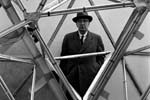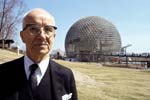
|

|
|
Home Site Search Contact Us Subscribe
|
|
A Filtered View #1: Buckminster Fuller (Not Al Gore) Invented the Internet By Charles F. Bloszies, FAIA October 14, 2015 Editor’s note: This is the first in a new series of musings by San Francisco-based architect Charles F. Bloszies, FAIA.
He walked onto the stage and, for an uncomfortably long time, said nothing, as if he were about to have a senior moment or worse. Finally he uttered something about how he wished those of us in the audience could see through his eyes – a crowd of bright young faces filled with hope and curiosity. Buckminster Fuller was all about the future. On April 18, 1968, he laid out the details of his freshly minted Operating Manual for Spaceship Earth, the topic of his keynote address at a plenary session of the 21st Annual Conference on World Affairs at the University of Colorado.
Not yet as famous as he would become, Fuller was already known as a 20th-century Jules Verne, an eccentric engineer type with an unusually broad intellect. He seemed to think that conventional wisdom was puerile. For example, when we jump up, we are not really jumping UP since the earth is a sphere. We are actually jumping OUT. People jumping in China are headed in the opposite direction from those of us jumping up here, so jumping out would be a more accurate description. He also seemed disturbed that architects didn’t know how much their buildings weighed, as if this were some sort of architectural vital sign that needed to be monitored regularly. His lecture that evening was a lengthy string of quasi-related notions about how the world worked, enlivened by all kinds of unusual references like these. At the end of the talk, he knitted together everything he had said in a manner that left you pondering these odd ideas, and wondering if they should be better embedded in the way you viewed the world.
Fuller put his principles into practice designing all kinds of clever things he believed were self-evident solutions to obvious problems. The Dymaxion car is but one example, a three-wheeled vehicle that could turn on a dime, aerodynamically sculpted so that with the addition of wings it might be able to fly. It didn’t quite catch on. Same with the geodesic dome. The idea here was to enclose a space under a surface of minimal area. He worked out a geometric network that resulted in a half-sphere using rods, all of which were the same length. Perhaps he should have gone on to design Dymaxion furniture, Dymaxion doors, and so on, because the geodesic dome didn’t quite accommodate the world of rectilinear shapes, and only garnered interest from a few devoted followers. These designs were the product of sophisticated engineering to be sure, but science alone doesn’t automatically yield the ideal solution – these objects all looked kind of funny.
A decade and a half later, a much more famous Fuller spoke as Professor Emeritus at the University of Pennsylvania. His address was part of a lecture series under the auspices of the Graduate School of Design featuring famous architects on the theme of what inspired their work. His talk followed the usual meandering, but attention-riveting pattern, and not once did he mention what inspired his designs. It was about the future, of course. He was excited by the possibility that electronic communication could lead to a true democracy; everyone’s voice could be heard through this exploding medium of instantaneous exchanges of information. He was telling this crowd of architects that the future was all about something other than the static edifices they were creating. Maybe we didn’t quite hear the message because we gave him a standing ovation that night despite his hint that our profession was about to become less relevant, or at least less interesting.
As it turns out, we still jump up, not out, and most buildings are just fine even though we don’t know exactly how much they weigh. Most of Fuller’s designs are now viewed as curiosities, but one idea he expressed that evening in Philadelphia really did catch on. That night, he invented the Internet. What he failed to foresee, though, is that the designers of this virtual network now call themselves architects.
Charles F. Bloszies, FAIA, is an architect, structural engineer, and writer – and principal of a practice in San Francisco focused on complex urban infill projects. He is the author of Old Buildings, New Designs – Architectural Transformations, published in 2011 by Princeton Architectural Press and now in its third printing.
|
(click on pictures to enlarge)  Matthew Millman Photography A Filtered View  Howard Sochurek/The LIFE Premium Collection/Getty Images Fuller looking through a geodesic dome  BoldRide.com Dymaxion Car, 1932  Magnum Photos via Walker Art Center Buckminster Fuller and his Montreal Expo ‘67 Dome |
© 2015 ArchNewsNow.com